About Us
About Whelan Lake Bird Sanctuary
Whelan Lake Bird Sanctuary in Oceanside California is a thriving year-round habitat for a wide variety of birds and wildlife, as well as an important stopover for countless migratory species. The Audubon Society conducts monthly bird counts here, and recent surveys have recorded more than 190 bird species at the lake. In fact, Whelan Lake ranks among the busiest of nearly 500 birding sites in San Diego County—with an impressive 73 species observed in a single day.
Our Vision
The Sanctuary’s vision is to honor the legacy of Ellen Whelan by preserving and protecting the land she generously entrusted to us in 1985. As an independent charitable organization, we are dedicated to maintaining and operating Whelan Lake as a thriving wildlife and bird sanctuary—ensuring its natural beauty and ecological value are safeguarded for generations to come.
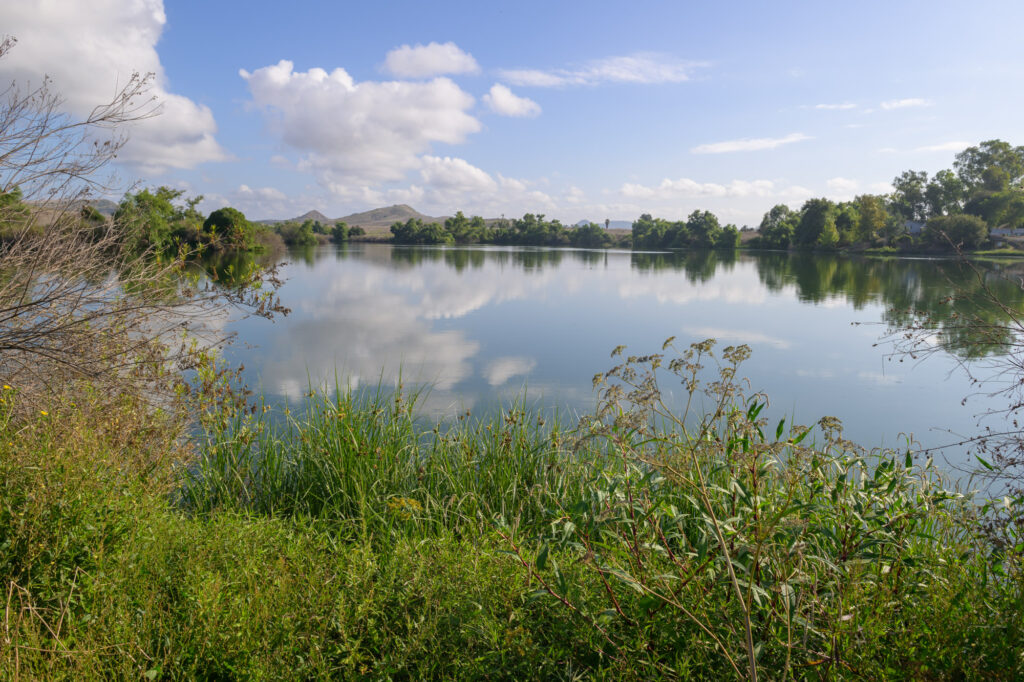
Our History and Ellen Whelan’s Legacy
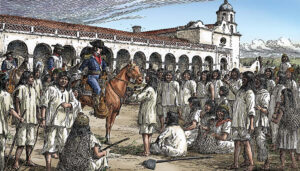
Luisenos, San Luis Ray Mission
For many years, Alta California was occupied by different groups of Native Americans later called Luisenos after the San Luis Rey Mission was established. The presence of shellfish remains, flaked stone artifacts and mortars indicate that the Indians had found the Whelan Ranch a congenial place to live since ancient times. In 1769, a Spanish expedition to Alta California led by Gaspar de Portola was to change their way of life forever.
The expedition led to the establishment by the Franciscans of 21 missions, stretching from San Diego to San Francisco and north to Sonoma. Among the missions founded was that of San Luis Rey, dedicated on June 13, 1798. Its jurisdiction extended over the surrounding countryside and included the area of Santa Margarita, which included Camp Pendleton and Whelan Ranch.
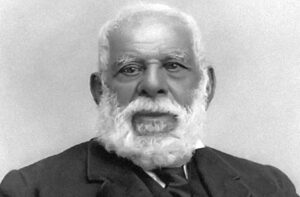
Pio Pico 1801-1894
After the overthrow of Spanish rule in 1822, Mexico secularized the mission lands between 1833 and 1834. Two brothers, Pio Pico (1801-1894), and his youngest brother, Andres (1810-1876), were appointed administrators of San Luis Rey Mission. Among the possessions of the Mission was the Rancho Santa Margarita, which Governor Alvarado granted to the brothers on May 10, 1941. Pio Pico became the last Mexican governor of California, serving in 1845 and 1846. Andres Pico became a general in the Mexican army, defeated the Americans at the battle of San Pasqual, December 6, 1846, and signed the Capitulation of Cahuenga in 1847 by which hostilities ceased between the Mexicans and Americans.
An older brother, Jose Antonio "Picito" Pico (1794-1871), was a lieutenant in the Mexican army. He purchased San Luis Rey Mission in 1846 but the purchase was later invalidated by the U.S. Land Commission. Jose Antonio kept a store in the Mission buildings and raised cattle on the nearby Rancho Santa Margarita. The Picos had a house at Pueblito (now Ysidora) on the same Rancho, near the San Diego-Los Angeles Stage Road, a distance of two or three miles from San Luis Rey Mission. Part of the old road can be seen still passing along the west side of Whelan Lake. It was at Pueblito that Jose Antonio Pico, and his wife, Magdalena Baca, raised their family which included two of their sons: Francisco "Pancho" Pico (1844-1909) and Pio Pico, Junior (1848-1938).
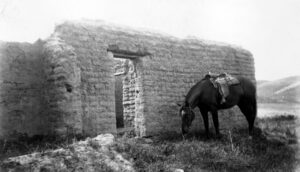
Francisco Pico's Adobe House
In 1868, Francisco Pico and his brother, Pio Pico, moved from Rancho Santa Margarita to the San Luis Rey Valley. Each settled on 160 acres of land, adjacent to each other, and next to present day Whelan Lake.
In 1869, a survey was made of the San Luis Rey area by James Pasco, who mentioned a “small lagoon”, near “Pico’s field” and “Pico’s house.” Pasco’s map of 1870 marked both these sites, referred to in 1992 as Whelan Lake and Whelan’s Ranch.
In 1873, Francisco and Pio Pico owned this property and took out patents for 160 acres each on August 20, 1874. The August 1, 1882 edition of the San Diego Union reported that “Col. Chalmers Scott had been in our valley during the past two or three days surveying land for Don Pancho Pico. Mr. Pico has informed us that he intends fencing, the same, and will erect a good substantial house soon. He proposes making an artesian well, and has great hopes of attaining water at a short distance.”
A drawing of Rancho Francisco Pico was made in 1882 and published in Elliot’s History of San Diego County in 1883. It shows the lagoon in nearby buildings. In 1891, Francisco and Dolores Pico assumed ownership of the land. Francisco Pico died in 1909.
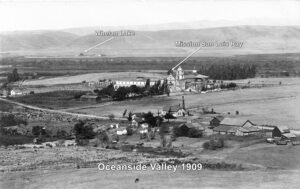
Oceanside Valley 1909
In 1911, John Whelan, a native of Ireland and a friend of Francisco Pico since 1893, rented the old 440-acre Pico Place upon the advice of Dolores Pico. Prior to living in California, Whelan married Ella Douglas, and went to live in Ripley County, Missouri. There three daughters were born to him and his wife: Mary (1878-1962), Lillian (1882-1941), and Helene "Shorty" (1883-1977).
With the coming of the railroads, John Whelan decided to move west to California, and more particularly to San Jacinto, in 1885. Four more children were born: John (1886-1940), Morris (1887), who died as a child, Douglas (1890-1932), and last, but not least, Ellen (1898-1985).
In San Jacinto, John Whelan worked as a teamster. San Jacinto was a thriving agricultural community near a river and lake that attracted migratory birds and geese. According to a newspaper account in the San Jacinto Valley Register, dated February 21, 1895, "Wild geese are said to be playing havoc with the grain fields bordering San Jacinto Lake." It was the sight of these geese that made a lifelong impression on Ellen Whelan. In later life, she remembered the sky as having been blackened with huge numbers of Canada Geese. Ellen lived in San Jacinto until she was thirteen years old, when the family moved to San Luis Rey.
John Whelan moved his family by wagon to the San Luis Rey Valley where he rented the 440-acre Rancho Pico.
The Oceanside Blade dated November 25, 1911 mentioned that “G. W. Everett had been employed
to repair and remodel the old house. Improvements to be made will cost upwards of $500.”
Whelan farmed hay, grain and sugar beets. In the disastrous floods of 1916, seventy-five acres were flood
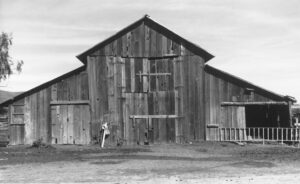
The Barn at Whelan Lake
ed. The old house, however, was untouched by the flood waters.
John Whelan retired from farming in 1921, and died in 1936 but Lillian and Douglas continued to run the ranch. In 1922, the Picos deeded the property to the San Diego County Water Company. After a Notice of Non-responsibility by the Water Company in 1932, Lillian Whelan assumed ownership in 1934.
It was Douglas who decided to go into the dairy business but he died in 1932 from an infected hand. At this time, his brother John left his job in San Diego and returned to San Luis Rey to help Lillian. The two managed the ranch until their deaths in 1940 and 1941.
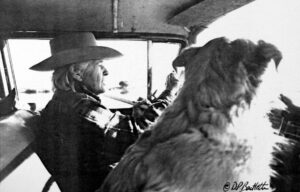
Ellen Douglas Whelan 1898-1985
It was the death of Lillian that caused Mary and Ellen Whelan to retire from teaching school in Los Angeles and to take over the family ranch in 1941. The property title was conveyed to Ellen and Mary Whelan in 1943.
In 1946, Ellen Whelan had a small dam erected at the south end of the lake, which increased the lake size to about twenty-five acres and enabled Miss Whelan to irrigate the pasture on the west side. In 1958, the City of Oceanside increased the height of the dam, and the lake size to thirty-seven acres, in order to use Whelan Lake as an oxidation pond. In addition, the city built a road twenty feet wide across the dam.
Mary Jane Whelan died at the ranch in 1962, leaving Ellen who many knew her as "Toots" to “hold the reins” at the Whelan Ranch Dairy. It was a hard life that suited her well. And she thrived on it. Feeding, milking, buying, selling, breeding, and herding her Holstein cows with a fierce determination that helped her mute the cries of skeptics and overcome inexperience.
Clad perennially in Levis, scuffed boots, an oversized work shirt and a battered Stetson, Whelan--who never married--was a striking figure in a tough industry rarely frequented by women. Although friends say she never hurt a fly, her independence and gruff, no-nonsense manner often evoked comparisons with the pistol-packing Annie Oakley.
In the early years, the dairy turned a profit. Whelan used her earnings to acquire surrounding land, on which her cattle grazed. At one point, she owned almost 900 acres and leased pastureland from neighboring Camp Pendleton as well. She won gold medals for the best milk in the county and bred prize-winning calves.
As the land around Oceanside was subdivided and built upon, the Canada Geese found it increasingly difficult to find pasture and water. They began to congregate on Whelan Lake in increasing numbers. Miss Whelan was delighted. She encouraged their presence by putting out feed, and she chased away hunters who trespassed on her land. In this manner, Miss Whelan made her ranch a sanctuary for the geese. Along with her huge pack of dogs and cattle, the thousands of migratory birds that rested each winter at Whelan Lake gave Ellen boundless joy. It was her concern for their future that led her to make a will in 1975 leaving her land as a wildfire and bird sanctuary. Her land was to provide a resting place for the geese.
The exact number of geese that came to Whelan Lake was unknown until 1975, when the Buena Vista Audubon Society organized its first “Christmas bird count.” 2,118 geese were counted in 1975. Their number increased to 4,537 in 1979. After a conservator was appointed to look after Miss Whelan's estate in 1980, their number declined.
During the 1980's, Whelan Lake was used as a dumping ground for dairy waste, and the lake became so polluted as to be unfit for wildfowl. In 1991-92, Whelan Lake was cleaned up and restored as a sanctuary for the geese and other wildlife.
Adapted from history written by Charmian Ariotti
Kristi Hawthorne, Oceanside Historical Society
Board of Directors
The Sanctuary is governed by a Board of Directors consisting of volunteer Board members.
Board of Directors History
We would like to extend our sincerest gratitude and thanks to the Board of Directors of the Whelan Lake Bird Sanctuary for their tireless dedication and commitment to protecting this precious habitat. Without their hard work, efforts, and passion for conservation, we would not be able to appreciate the beautiful wildlife at this site today. We applaud them wholeheartedly for their courage, tenacity, and commitment throughout their journey. Thank you!
Present
Cutter Clotfelter (2014-present)
Cy R. Kackstetter (2018-present)
Knox Bell (1988-present)
Roxanne Greene (2019-present)
Howard Mees (2014-present)
Abel Moreno (2007-present)
Brent Jobe (2001-present)
John Zapf (2023 -present)
Roger Carlson (2025-present)
Tom Carrillo (2025-present)
Advisors
Jane Mygatt (2024-present)
Past
Sheldon Tyson (1988-1995)
David Rorick (1988-2001)
John Oakley (1988-2020)
Thomas Clotfelter (1988-2014)
Thomas Perlowski (1988-2017)
Charmian Ariotti (1988-1996)
Joseph Jehl (1988-1993)
Joan Jackson (1988-1992)
Frank Todd (1988-1990)
Mitts Nagata (1988-1990)
Jeffrey Chandler (1990-1993)
James Turner (1993-1996)
Barry Martin (1993-2004)
Juan Gonzalez (1993-2015)
Inez Martinez (1993-2002)
Alice Goodkind (1996-2002)
Suzanne Spann (2004-2006)
Barbara Moore (2005-2014)
Alfredo Gonzales (2005-2018)
Michael Lloyd (2009-2011)
Stephen Shillington (2009-2011)
Andy Mauro (2012-2014)
Harvey Schroeder (2013-2019)
